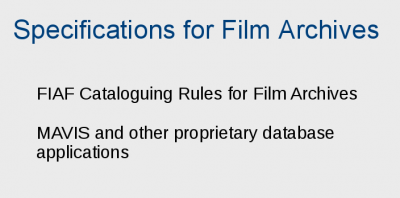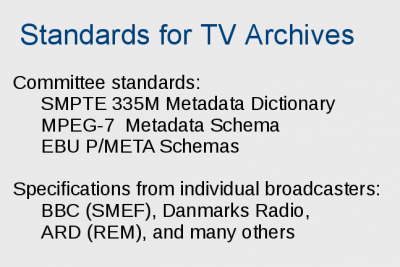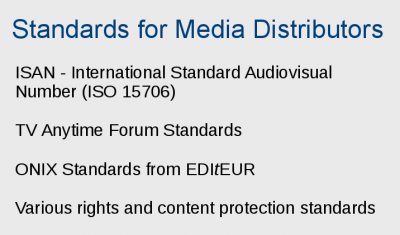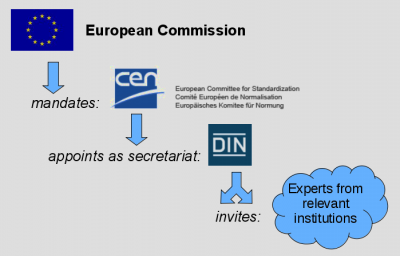How EN 15744 and EN 15907 came into being
From filmstandards.org
From the TC 372 Workshop Compendium
So many standards to choose from ...
... and still nothing that fits the purpose?
Metadata about audiovisual media comes in many shapes. Depending on the usage context, it can focus on the physical or digital artefact, the public release, the artistic creation, the commercial product, the historical evidence, or whatever.
So far, only few efforts have been untertaken to integrate at least some of these contexts within a metadata specification.
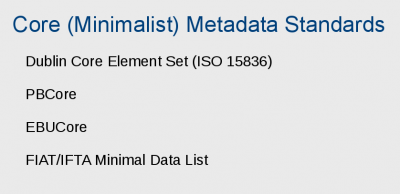
|
Dublin Core is an ubiqitous standard applied to all kinds of digital resources. Using it for cinematographic works is problematic, however, since e.g. the notion of creator does not match well with the notions of cast and credits. PBCore is a simple schema used for metadata exchange among public broadcasters in the U.S. EBUCore is a minimalist counterpart to P/Meta, recently introduced by the European Broadcastung Union. The FIAT/IFTA data element list is a members-only document. EN 15744 can also be regarded as a core or minimalist standard. |
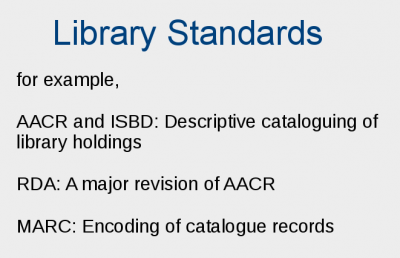
|
Library standards are widely used in film archives, predominantly for non-film items and for film copies available for viewing. Library standards are known for good interoperability among compliant implementations and for poor interoperability with most other metadata standards. RDA offers a choice of encodings in addition to MARC. For a discussion of RDA interoperability issues, see [1] |
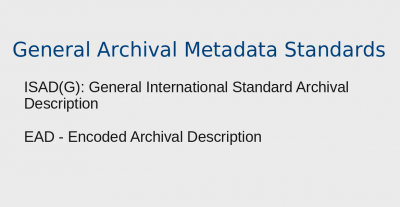
|
These standards define elements and terminology for describing the contents of archives from the fonds level down to the item level. EAC defines an XML-based encoding for such descriptions. |

|
CCO grew out of a set of rules for describing images of museum objects and includes rules for objects as well as for collections of these. VRA Core is an encoding scheme for descriptions based on CCO, centered around three major entities: collection, object, and image. CDWA is a comprehensive model and rule set for many kinds of objects relevant to the cultural heritage community. It has many definitions in common with CCO. LIDO is an XML-based encoding of a subset of CDWA, using concepts of the CIDOC Conceptual Reference Model. LIDO Version 1.0 has been released in November, 2010. |
| • • • |
Creating a new metadata initiative
Researching the audiovisual heritage is a complex and time-consuming task, even in an era with plentiful resources on the Web, and powerful search engines always at your fingertips. In recognition of this fact, the European Commission decided to support efforts towards an improved infrastructure for information about cinematographic works.
One outcome of this support is the creation of two metadata specifications designed to make present and future filmographic databases more interoperable.
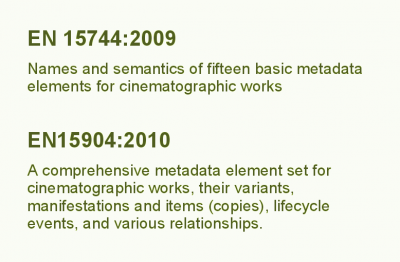
|
These are the standards that will be the subject of this workshop. How and why did they come into being? What can we do with them that cannot be done with other standards for audiovisual metadata? |
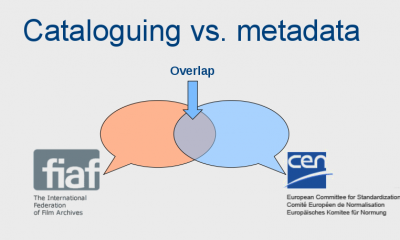
|
Initially, the EU mandate included the development of cataloguing rules. This was soon withdrawn when it became clear that it would mean a duplication of the efforts of the FIAF Cataloguing and Documentation Commission, with potentially conflicting results. Some overlap remains, however. For example, referring to the FRBR reference model (more on this later) from a filmographic metadata specification will inevitably influence the approach to cataloguing. |
